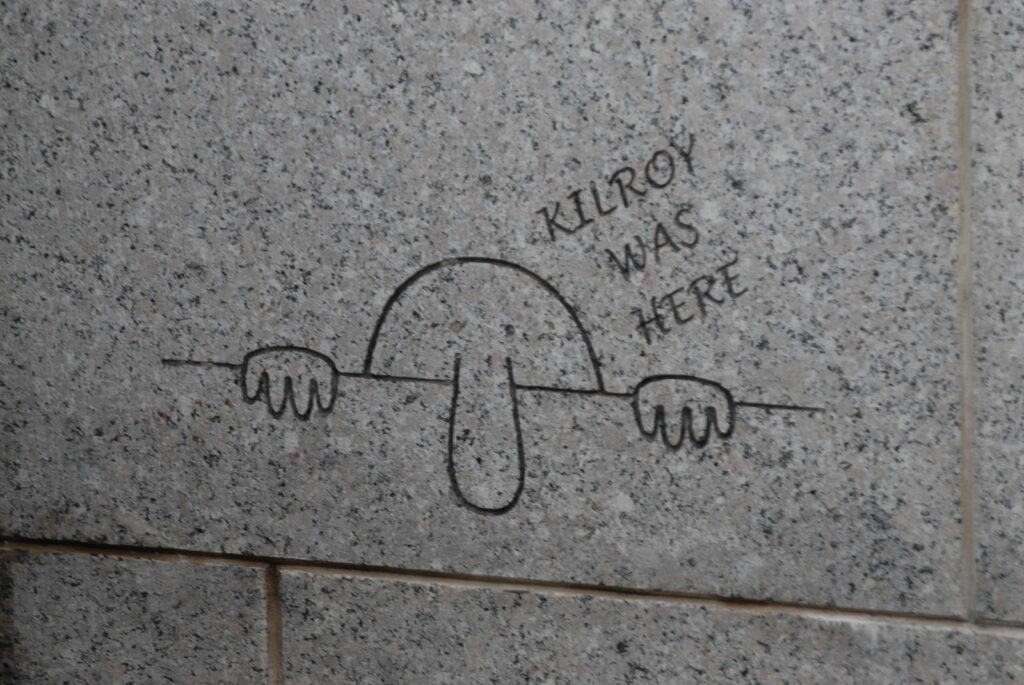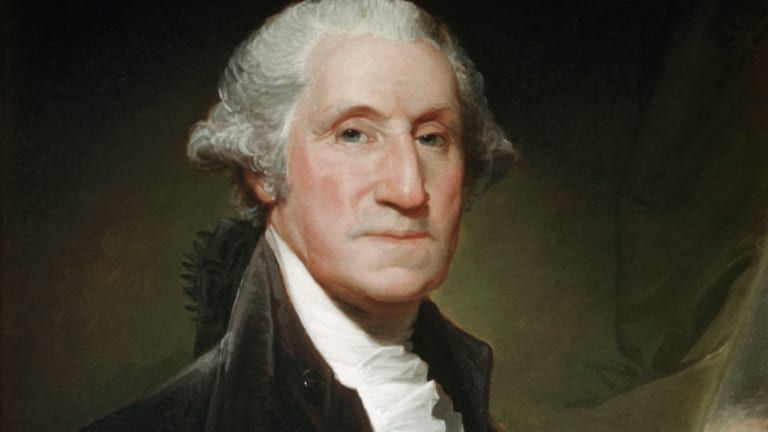Last updated on October 9th, 2023 at 07:52 pm
In times of war, the movement of soldiers often leaves trails of death and destruction in its wake. But rarely, they happen to leave behind small acts of humor and mischief.
“Kilroy Was Here” was one such mark. A simple phrase accompanied by a cartoonish drawing of a man peering over a wall. This graffiti became a ubiquitous symbol of American military presence during World War II. It adorned everything from bathroom stalls to missile shells.
Its origins are shrouded in mystery, and the myths and legends surrounding it have only added to its enduring appeal.
So where did the iconic Kilroy drawing come from, and why did the simple meme capture the imaginations of soldiers and civilians alike? How did it endure through the war and spread across the globe?
Most importantly, what can it tell us about the brave men and women who left it in their wake – a mark of humor among humanity’s greatest horrors?

The Origins of “Kilroy Was Here”
During World War II, the voracious spread of “Kilroy Was Here” began. Unbeknownst to anyone at the time, it would become a legendary, almost mythical part of American military culture and the history of the war.
The basic doodle featured a bald man with a large nose. His head and hands were peering suspiciously over a wall along with the tag “Kilroy Was Here.” It could soon be found across all theaters of war visited by American troops.
Kilroy was found in ship holds, bathrooms, bridges, and walls, and even painted on the shells of Air Force missiles. It was found scrawled across France, Germany, the entire Pacific theater, and more.
The graffiti’s popularity grew to the point where it transcended the battlefield. It was found just about everywhere it could be spray-painted, carved, drawn, or left behind in some shape or form, no matter the country.
In 1944, war photographer Robert Capa photographed an instance of the meme at Bastogne during the Battle of the Bulge. Soldiers had written “Kilroy Was Stuck Here” on the walls of an abandoned barn.
It is even rumored that during the Potsdam Conference in 1945, Stalin happened to stumble upon a drawing of “Kilroy Was Here” in the VIP bathroom. He supposedly inquired with his aides, asking who Kilroy was, to which one can only guess what their answer was.
Even Japanese enemy forces were confused and intrigued by the tiny man peering over the wall. Japanese troops were reported to be perplexed by the meme they found all over the Pacific theater. They found it painted onto the sides of tanks and missiles in Guadalcanal and other islands.
During the war and in the years since the myths surrounding “Kilroy Was Here” continued to proliferate wildly.
News of Kilroy’s appearances across Europe made it to the highest ranks of German intelligence. Potentially even to Adolf Hitler, who may have believed that it was the mark of a high-level allied spy, one who went anywhere he wanted, undetected across enemy territory.
Kilroy’s most notable appearances are the two inscriptions hidden in the World War II memorial in Washington D.C. Tucked away, in small unassuming corners of both the Atlantic and Pacific sides of the memorial, Kilroy has been carved into the marble. It serves as a tribute to his legacy and impact on the war effort.
Many myths and legends cropped up to explain the sometimes baffling and mystifying graffiti man. However, the “Kilroy Was Here” phenomenon was primarily – and remains so – a lasting symbol of the American military during World War II and beyond.
Kilroy even made a comeback in the days of the Korean War. He was similarly spotted in Iraq and Afghanistan.
Wherever American troops go, Kilroy seems to follow.
Meaning Behind the Meme
“Kilroy Was Here” was more than just a simple doodle. It was a symbol of pride and perseverance for American soldiers during World War II.
As they fought their way across the globe, the image of the bald man peering over a wall accompanied by the tag “Kilroy Was Here” appeared in plenty of unexpected places. It boosted the spirits of the battle-weary soldiers.
The appearance of “Kilroy Was Here” also became a competition for soldiers. They vied for the chance to inscribe the graffiti in obscure locations, which added to its allure and mystery.
Most importantly, the Kilroy character represented a belief that someone came before and made it out. It served as a beacon of hope for soldiers during the war.
It, therefore, represented not just American military culture, but also the tenacity and bravery of the American spirit.
When soldiers stormed a beach, took over an objective point, or liberated a town, seeing the words “Kilroy Was Here” reminded them that they could conquer anything and win the war.
While the “Kilroy Was Here” fad was a quintessential, emblematic part of World War II and the 1940s, it was far more just a tagline or a cartoon. It was a symbol of resilience and determination.
American author William Faulkner was quoted in Lion in the Garden as saying, “What matters is at the end of life, when you’re about to pass into oblivion, that you’ve at least scratched ‘Kilroy was here’ on the last wall of the universe.”
What Faulkner was getting at was that no matter what happened, the thought that what you contributed would be remembered by others and live on after you was a comforting one.
“Kilroy Was Here” transcended the battlefield and became an encouraging sign of overcoming adversity and finding the lighter side of life. No matter how difficult the circumstances may be.
Overall, “Kilroy Was Here” was a powerful symbol of American strength and determination during World War II. It represented the ability to triumph over adversity and find humor in even the darkest of situations.
Its legacy continues to inspire soldiers and civilians alike to this day.

Who Was Kilroy?
The origins of the phrase, “Kilroy Was Here,” and the real Kilroy are very murky and remain unclear. It is still shrouded in urban legend. To date, no certain origins have been traced for the popular meme, but there are plenty of potential explanations.
Most historians believe that the most credible source comes from the Fore River shipyard in Quincy, Massachusetts. This is where a man by the name of James Kilroy worked as a rivet inspector during World War II.
At home, the war effort raged on in the factories and industrial hubs of the country. They were producing massive amounts of ammunition, planes, vehicles, and other war materials. And Kilroy’s Fore River shipyard was an integral part of it.
As an inspector, Kilroy was responsible for checking the work of riveters. They were paid based on the number of rivets they installed.
To prevent the riveters from erasing his inspection marks, the clever American shipyard inspector began marking his approved work with the phrase “Kilroy was here” in more durable crayon. This allowed him to ensure that the riveters were not paid double for their work.
Kilroy’s markings were normally painted over during the shipbuilding process. But the urgent need for ships overseas meant that most were launched into action before they were covered up.
As a result, “Kilroy Was Here,” would have been seen by thousands of servicemen who sailed aboard the troop ships built at Quincy. American GIs began to notice the odd, puzzling phrase scrawled on outgoing ships almost immediately.
Kilroy’s marks were also found in places that nobody could reach for graffiti, such as inside sealed hull spaces. This provides more evidence to the claim.
Sailors at first treated an appearance of “Kilroy Was Here” as a kind of good luck charm. It also indicated that their ship was properly checked and protected against the enemy. GIs later adopted Kilroy’s tag – likely for the fun of it. And so, they began tagging the places they’d visited across Europe, Asia, and Africa.
This led to the phrase “Kilroy Was Here” becoming a ubiquitous sight on ships and other military equipment. It’s uncertain where the drawing of the bald man joined the picture during this timeline. But, likely, it started somewhere in the very beginning.
Other ideas as to the real identity of Kilroy have cropped up. This includes images such as Sergeant Francis Kilroy Jr. However, this seems to be less likely.
Either way, the origins of “Kilroy Was Here,” present a confounding, confusing puzzle, and we may never know the truth.
Other Versions of “Kilroy Was Here”
In addition to “Kilroy Was Here,” other similar memes and drawings cropped up across the European theater during World War II.
The most popular among these variants was known as “Mr. Chad.” Chad was a construction of British forces during the war. He was often depicted with curled hair that looked like a question mark and crosses in his eyes. His accompanying tagline was “Wot, no sugar?”
Variations of the “Wot, no –” phrase were commonly used by British servicemen to express frustration with shortages and rationing, and other issues of life in the military.
Mr. Chad was often found alongside his American counterpart, Kilroy. It’s unclear which of the two came first, but undoubtedly, the two memes grew and evolved with one another. Similar to how the American and British forces served together throughout the campaign.
The first drawing of the lovable, little character may have originated with a British cartoonist in the 1930s. However, some argue it was a riff on the Greek symbol, omega, to symbolize ‘resistance.’
Whatever the true origin was, it became so widely used that it was eventually known worldwide. Like Kilroy, it was even found scrawled on the walls of the Houses of Parliament in London.
As rationing became less common, Chad fell out of popular use. But he can still be seen occasionally on walls and in references in pop culture.
Another similar figure to Kilroy and Chad was “Smoe.” The phrase “Kilroy was here” was often accompanied by “And so was Smoe” throughout the European theater.
Unlike Kilroy, Smoe did not enjoy a post-war resurgence of interest and already disappeared from popular use by the end of 1946.
“Foo Was Here” was another variation. This one was popularized by the Royal Australian Air Force, but its connection to Kilroy is unclear.
All in all, the variations of the Kilroy tag, such as Chad or Smoe, gradually fell out of use and pop culture moved on to new trends and fads. They never did experience the cultural longevity and cult-like status of their brother-in-arms, Kilroy.
Kilroy’s Fame and Cult-like Status After WWII
After the end of World War II, Kilroy’s fame continued to grow.
The phrase “Kilroy Was Here” became a ubiquitous pop culture symbol of the American military. It was seen everywhere from the walls of bombed-out buildings to the helmets and tanks of American soldiers.
The tag even found its way onto the Arc de Triomphe in Paris.
As the war ended and American soldiers began returning home from their military service, they brought Kilroy with them. Soon, the bald man peering over the wall was appearing all over the United States, on train cars, bridges, and billboards.
Kilroy even made an appearance in Hollywood, where he appeared in many films and cartoons.
Kilroy’s fame and cult-like status were fueled in part by the mystery surrounding his origins. Nobody knew for sure who Kilroy was or where he came from. This only added to his allure. People began to invent their own stories about Kilroy, and he took on a life of his own.
The “Kilroy Was Here” tag also became a symbol of graffiti and street art. Many artists incorporated the character into their works. This further contributed to its fame and popularity.
Kilroy’s fame inspired many imitations and variations. Different countries and organizations adopted their own versions, which made it a global sensation.
The Kilroy phenomenon continued into the 1950s and beyond. It appeared in new and unexpected places. Kilroy even made an appearance in space, with an astronaut drawing the tag on a wall of the International Space Station in 2003.
In the end, “Kilroy Was Here” was much more than just a pop culture meme or a cartoon. It remains a testament to the strength of the human spirit during one of the darkest periods in modern history.
The next time you see the words “Kilroy Was Here” scrawled on a wall or etched into a park bench, take a moment to remember the individuals who made those marks and the sacrifices they made.
References
Blouin, Buddy. “Kilroy Was Here: The Infamous WWII Meme That Lives On.” VeteranLife, 27 Apr. 2022, https://veteranlife.com/military-history/kilroy-was-here/.
“Kilroy Was Here (U.S. National Park Service).” National Parks Service, U.S. Department of the Interior, https://www.nps.gov/places/https-www-nps-gov-wwii-kilroy-was-here.htm
Whipps, Heather. “How ‘Kilroy Was Here’ Changed the World.” LiveScience, Purch, 15 Sept. 2008, https://www.livescience.com/7577-kilroy-changed-world.html.

